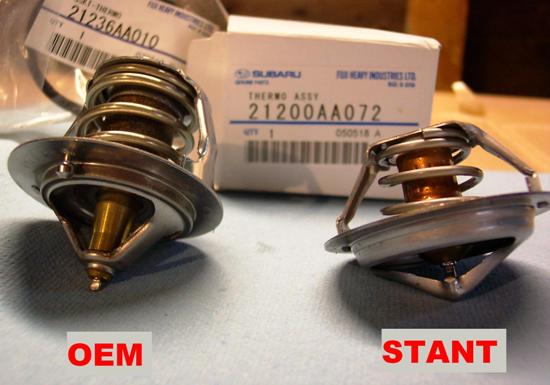DRAINING AND REPLACING COOLANT AND THERMOSTAT
I like to do this maintenance every three years or so of normal driving to keep the cooling system in tiptop shape. If you haven't had any overheating problems, you may decide not to replace the thermostat and/or radiator cap at this interval and I'm certainly not going to tell you you're wrong. But, many problems on our cars can be avoided by not overheating the engine and there really is no downside to being aggressive on this maintenance except spending a little time and money.
The graphics and steps below apply specifically to my 1997 OBW, but most should be applicable to both older and newer cars, as well.
This job can be done with your car on a level garage floor, but there are advantages to raising the front of the car. Easiest way is to drive the front tires up on 2x boards or (better) 2 stacked 2x boards. Alternatively, place front of car on jack-stands. Raising the front will give easier access to the thermostat and make it less likely to trap air in the system when filling the system with coolant.
I'm located in the U.S. with a left-hand drive car, so consider all references to "passenger-side" or "driver's-side" accordingly.
Parts you will need:
-Thermostat (Genuine Subaru only ... aftermarket ones don't seem to work well with our cars)
-Thermostat Gasket (recommended)
-Radiator Cap (optional, but if the thermostat needs replacing ... a "tired" cap can cause overheating problems)
-Either:
1-gallon of full-strength coolant and 1-gallon of distilled water *OR*
2 gallons of 50/50 premix coolant
-Subaru cooling system additive (optional for Gen1 but recommended for newer cars to prevent external head gasket leaks)
Subaru recommends using an "ethylene-glycol basis coolant". For the last few years, I have been using Peak Long-life coolant (green color) successfully. Others on this forum have reported using a Prestone brand coolant just as successfully. Of course, your local dealer will recommend and be glad to sell you Subaru brand coolant. Your choice.
If you live in a area with "soft" water, i.e. not mineralized, you may decide to use tap water with the full-strength coolant. But a gallon of distilled water only costs a dollar or so at the grocery store, so why not? Use the leftover for your battery.
Due to shipping charges, it's usually not feasible to order these parts online unless they're part of a larger order, so plan to buy locally. Warning: local dealers reputedly love to "gouge" walk-in customers. If you just walk into the dealer to get these parts, they will probably charge you 10-20% over list price. Call ahead or contact them via email for a price quote and use your negotiating tactics to get the price down. The only items you HAVE to get at the dealer are the thermostat and the additive.
TOOLS NEEDED:
-safety glasses
-10mm wrench or socket to remove thermostat housing bolts and radiator overflow tank mounting bolts
-pliers to loosen radiator drain valve
-phillips head screwdriver to loosen hose clamp and remove air vent plug from radiator
-towels to clean-up the inevitable spills
-safety glasses
Let's get started:
-Let engine sit and cool ... overnight is good.
-Remove radiator cap and open drain valve on radiator and drain coolant into a bucket. The drain valve is located on the rear passenger side of the radiator near the bottom. TIP: pull the hose from the radiator overflow tank and slip it onto the drain valve (it fits perfectly) to better direct flow into the bucket and save making a mess.
![Image]()
-Close drain valve (remove overflow tank hose, if used).
-Under the car (driver's side), have a bucket ready to catch coolant and remove the two bolts on the thermostat housing to separate it from the water pump and pull it down. The Subaru manual recommends removing the lower radiator hose from the housing but I haven't found it necessary to do so.
-Remove thermostat by pulling it down ... you might need a screwdriver to gently pry it out. Note which end of thermostat goes up so new one can be inserted in the same direction. Retain rubber gasket around the thermostat flange if you don't buy a new one.
![Image]()
![Image]()
OPTIONAL STEPS:
-Place bucket under water pump, remove upper radiator hose at radiator end, run garden hose into hose to "flush" dirt and remaining old coolant from the engine.
-Run garden hose into upper radiator pipe to "flush" dirt and old coolant from the radiator.
-Reinstall radiator hose.
-NOTE: If you wish to do a chemical flush, reinstall the old thermostat and follow directions on the container you purchased. Afterwards, you will probably want to repeat all the steps above.
-NOTE: if you wish to test the new thermostat before installing, see instructions on graphic below.
![Image]()
-Install the new thermostat with gasket. The Subaru manual says to set the jiggle pin of the thermostat to the front side.
-Place thermostat housing on bottom of water pump and tighten bolts to specified torque.
-Remove radiator overflow tank and empty into bucket, clean, then reinstall tank.
-NOTE: Follow directions on container for adding the Subaru Coolant Additive, if used. I have not used this, so don't know what they are, but if you fill the radiator with coolant, there will be no room for the additive and you will have to drain some coolant to make room.
ADDING COOLANT:
-Remove air vent plug from top of radiator (passenger-side) using phillips screwdriver.
-Slowly add coolant to radiator. If using full-strength coolant, add 3/4 gallon then top off with distilled water. If using premix, add until full, about 1.5 gallons. If you add significantly less than 1.5 gallons total, there is air trapped in the system.
-Replace air vent plug
-Replace radiator cap
-Add coolant to full mark on overflow tank.
There are several methods for adding coolant and purging air trapped in the system. If you raised the front end on boards, this will help. The method Subaru has in the manual is:
-Remove air vent plug from radiator.
-Fill engine coolant into radiator up to filler neck position.
-Fill engine coolant into reservoir tank up to upper level.
-Attach radiator cap and reservoir tank cap properly.
-Install air vent plug.
-Warm-up engine completely for more than five minutes at 2,000 to 3,000 rpm.
-Stop engine and wait until temperature drops to a safe level.
-If engine coolant level drops in radiator, add engine coolant to filler neck position.
-If engine coolant level drops from upper level of reservoir tank, add engine coolant to upper level.
-Attach radiator cap and reservoir tank cap properly.
Remember:
Check for leaks.
Recycle old coolant at auto parts store.
I like to do this maintenance every three years or so of normal driving to keep the cooling system in tiptop shape. If you haven't had any overheating problems, you may decide not to replace the thermostat and/or radiator cap at this interval and I'm certainly not going to tell you you're wrong. But, many problems on our cars can be avoided by not overheating the engine and there really is no downside to being aggressive on this maintenance except spending a little time and money.
The graphics and steps below apply specifically to my 1997 OBW, but most should be applicable to both older and newer cars, as well.
This job can be done with your car on a level garage floor, but there are advantages to raising the front of the car. Easiest way is to drive the front tires up on 2x boards or (better) 2 stacked 2x boards. Alternatively, place front of car on jack-stands. Raising the front will give easier access to the thermostat and make it less likely to trap air in the system when filling the system with coolant.
I'm located in the U.S. with a left-hand drive car, so consider all references to "passenger-side" or "driver's-side" accordingly.
Parts you will need:
-Thermostat (Genuine Subaru only ... aftermarket ones don't seem to work well with our cars)
-Thermostat Gasket (recommended)
-Radiator Cap (optional, but if the thermostat needs replacing ... a "tired" cap can cause overheating problems)
-Either:
1-gallon of full-strength coolant and 1-gallon of distilled water *OR*
2 gallons of 50/50 premix coolant
-Subaru cooling system additive (optional for Gen1 but recommended for newer cars to prevent external head gasket leaks)
Subaru recommends using an "ethylene-glycol basis coolant". For the last few years, I have been using Peak Long-life coolant (green color) successfully. Others on this forum have reported using a Prestone brand coolant just as successfully. Of course, your local dealer will recommend and be glad to sell you Subaru brand coolant. Your choice.
If you live in a area with "soft" water, i.e. not mineralized, you may decide to use tap water with the full-strength coolant. But a gallon of distilled water only costs a dollar or so at the grocery store, so why not? Use the leftover for your battery.
Due to shipping charges, it's usually not feasible to order these parts online unless they're part of a larger order, so plan to buy locally. Warning: local dealers reputedly love to "gouge" walk-in customers. If you just walk into the dealer to get these parts, they will probably charge you 10-20% over list price. Call ahead or contact them via email for a price quote and use your negotiating tactics to get the price down. The only items you HAVE to get at the dealer are the thermostat and the additive.
TOOLS NEEDED:
-safety glasses
-10mm wrench or socket to remove thermostat housing bolts and radiator overflow tank mounting bolts
-pliers to loosen radiator drain valve
-phillips head screwdriver to loosen hose clamp and remove air vent plug from radiator
-towels to clean-up the inevitable spills
-safety glasses
Let's get started:
-Let engine sit and cool ... overnight is good.
-Remove radiator cap and open drain valve on radiator and drain coolant into a bucket. The drain valve is located on the rear passenger side of the radiator near the bottom. TIP: pull the hose from the radiator overflow tank and slip it onto the drain valve (it fits perfectly) to better direct flow into the bucket and save making a mess.
-Close drain valve (remove overflow tank hose, if used).
-Under the car (driver's side), have a bucket ready to catch coolant and remove the two bolts on the thermostat housing to separate it from the water pump and pull it down. The Subaru manual recommends removing the lower radiator hose from the housing but I haven't found it necessary to do so.
-Remove thermostat by pulling it down ... you might need a screwdriver to gently pry it out. Note which end of thermostat goes up so new one can be inserted in the same direction. Retain rubber gasket around the thermostat flange if you don't buy a new one.
OPTIONAL STEPS:
-Place bucket under water pump, remove upper radiator hose at radiator end, run garden hose into hose to "flush" dirt and remaining old coolant from the engine.
-Run garden hose into upper radiator pipe to "flush" dirt and old coolant from the radiator.
-Reinstall radiator hose.
-NOTE: If you wish to do a chemical flush, reinstall the old thermostat and follow directions on the container you purchased. Afterwards, you will probably want to repeat all the steps above.
-NOTE: if you wish to test the new thermostat before installing, see instructions on graphic below.
-Install the new thermostat with gasket. The Subaru manual says to set the jiggle pin of the thermostat to the front side.
-Place thermostat housing on bottom of water pump and tighten bolts to specified torque.
-Remove radiator overflow tank and empty into bucket, clean, then reinstall tank.
-NOTE: Follow directions on container for adding the Subaru Coolant Additive, if used. I have not used this, so don't know what they are, but if you fill the radiator with coolant, there will be no room for the additive and you will have to drain some coolant to make room.
ADDING COOLANT:
-Remove air vent plug from top of radiator (passenger-side) using phillips screwdriver.
-Slowly add coolant to radiator. If using full-strength coolant, add 3/4 gallon then top off with distilled water. If using premix, add until full, about 1.5 gallons. If you add significantly less than 1.5 gallons total, there is air trapped in the system.
-Replace air vent plug
-Replace radiator cap
-Add coolant to full mark on overflow tank.
There are several methods for adding coolant and purging air trapped in the system. If you raised the front end on boards, this will help. The method Subaru has in the manual is:
-Remove air vent plug from radiator.
-Fill engine coolant into radiator up to filler neck position.
-Fill engine coolant into reservoir tank up to upper level.
-Attach radiator cap and reservoir tank cap properly.
-Install air vent plug.
-Warm-up engine completely for more than five minutes at 2,000 to 3,000 rpm.
-Stop engine and wait until temperature drops to a safe level.
-If engine coolant level drops in radiator, add engine coolant to filler neck position.
-If engine coolant level drops from upper level of reservoir tank, add engine coolant to upper level.
-Attach radiator cap and reservoir tank cap properly.
Remember:
Check for leaks.
Recycle old coolant at auto parts store.






